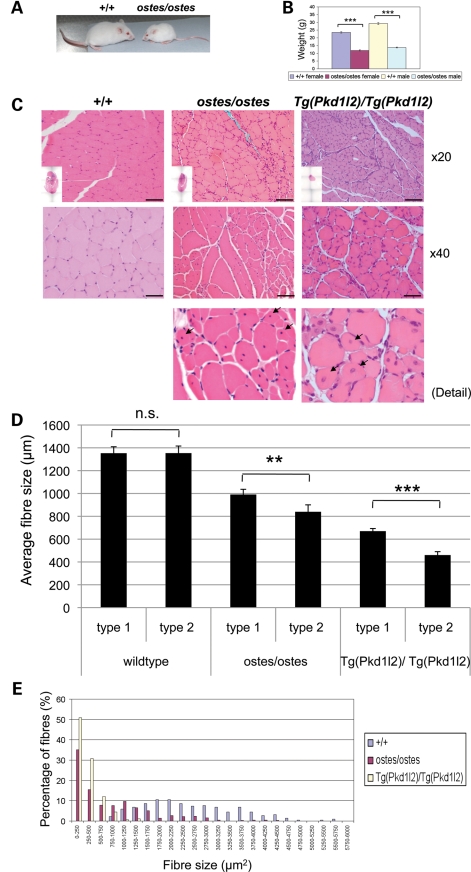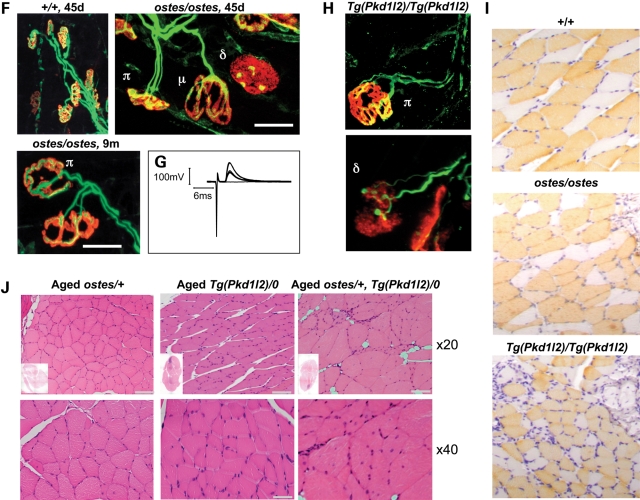Figure 1.
Neuromuscular phenotypes of ostes and Tg(Pkd1l2) mice. (A) Photograph of representative 5-week-old wild-type (+/+) and ostes/ostes mice. Ostes/ostes mice are small and weigh less than wild-type mice from 3–5 weeks of age. (B) Weight of 12-week-old wild-type (+/+) and ostes/ostes mice. Both male and female ostes/ostes mice weigh significantly less than wild-type mice at 12 weeks of age (females: P = 5.873E − 16, n = 9 ostes/ostes, 22 wild-type; males: P = 1.143E − 12, n = 11 ostes/ostes, 22 wild-type). Data are represented as mean ± SEM. (C) Representative sections of gastrocnemius skeletal muscle from 45-day-old wild-type (+/+), ostes/ostes and Tg(Pkd1l2)/Tg(Pkd1l2) mice, stained with H&E. Evidence of degenerative changes are present in ostes/ostes muscle, including muscle atrophy, small fibres, striking fibre size asymmetry, pyknotic nuclei and centrally nucleated fibres (arrows). Muscles from 45-day-old Tg(Pkd1l2)/Tg(Pkd1l2) mice show similar pathological hallmarks. Scale bar: ×20 magnification, 100 μm, ×40, 50 μm. Inset: H&E-stained levelled cross-sections of whole hind limbs from the same mice show the reduced size and muscle atrophy in ostes/ostes and Tg(Pkd1l2)/Tg(Pkd1l2) hind limbs. (D) Mean fibre size according to fibre type in soleus muscle from wild-type (+/+), ostes/ostes and Tg(Pkd1l2)/Tg(Pkd1l2) mice. Mean fibre size in both ostes/ostes and Tg(Pkd1l2)/Tg(Pkd1l2) skeletal muscle is reduced compared with wild-type. Type-2 fibres show a small but significant reduction in size in ostes/ostes and Tg(Pkd1l2)/Tg(Pkd1l2) muscle. Fibre size was analysed in MYH7-stained sections (slow twitch) of soleus muscle from three 45-day-old mice containing at least 80 fibres each. Data are represented as mean ± SEM. (E) Fibre size distribution in 45-day-old wild-type (+/+), ostes/ostes and Tg(Pkd1l2)/Tg(Pkd1l2) skeletal muscle. Fibre size was analysed in five H&E-stained sections of gastrocnemius from 45-day-old mice containing at least 80 fibres each. (F) Immunofluorescence photographs of NMJs in wholemount lumbrical muscle from wild-type (+/+) and ostes/ostes mice. Acetylcholine receptors are labelled in red, and presynaptic boutons and axons in green. Wild-type (+/+) endplates are mononeuronally innervated, with one axon leading to each endplate. Ostes/ostes endplates show both normal mononeuronal innervation (μ), alongside abnormal polyneuronal innervation (π) where two or more axon terminals innervate one endplate, in both 45-day-old and 9-month-old mice. In addition, some ostes/ostes endplates are denervated (δ), characterized by a plaque-like morphology of acetylcholine receptor staining and only partial or absent occupation by axon terminals. Scale bar, 20 µm. (G) Example of an intracellular recording of nerve-evoked EPPs from an ostes/ostes EDL muscle, showing functional polyneuronal innervation. (H) Immunofluorescence photographs of NMJs in wholemount hind limb muscle from 26-day-old Tg(Pkd1l2)/Tg(Pkd1l2) mice. Examples of an abnormal polyneuronal innervation (π) and a plaque-like partially denervated endplate (δ) are shown. (I) Fibre type analysis of levelled cross-sections of 45-day-old +/+, ostes/ostes and Tg(Pkd1l2)/Tg(Pkd1l2) hind limb skeletal muscle. There is no evidence of fibre type grouping, and fibre size asymmetry does not correlate with specific fibre type in either ostes/ostes or Tg(Pkd1l2)/Tg(Pkd1l2) muscle. (J) Representative sections of gastrocnemius skeletal muscle from aged (>6 months) ostes/+, Tg(Pkd1l2)/0 and ostes/+, Tg(Pkd1l2)/0 mice, stained with H&E. Ostes/+ skeletal muscle shows similar but much milder pathological hallmarks than ostes/ostes muscle, and no evidence of overall muscle atrophy. Skeletal muscle from hemizygous Tg(Pkd1l2)/0 mice does not show any obvious myopathic changes or atrophy. However, skeletal muscle from aged ostes/+, Tg(Pkd1l2)/0 mice shows marked fibre size asymmetry, very small fibres and centrally nucleated regenerating fibres. Scale bar: ×20, 100 μm, ×40, 50μm. Inset: H&E-stained cross-sections of whole hind limbs from the same mice show no significant differences in size.


